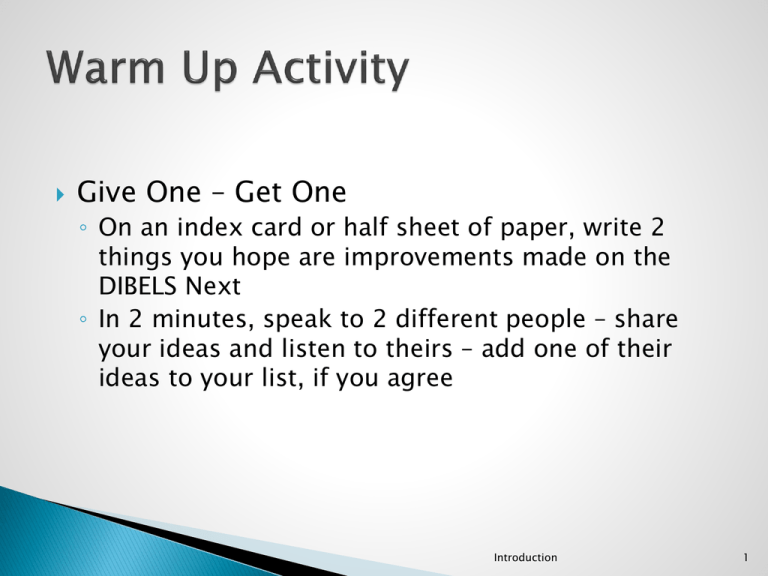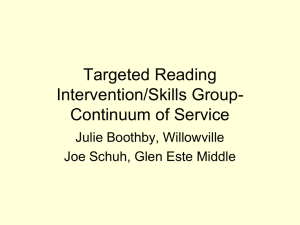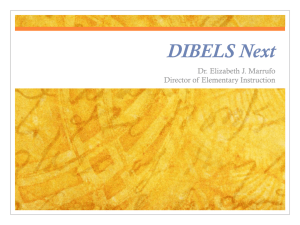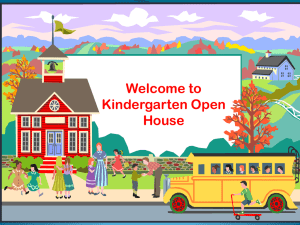DIBELS Next Transition
advertisement

Give One – Get One ◦ On an index card or half sheet of paper, write 2 things you hope are improvements made on the DIBELS Next ◦ In 2 minutes, speak to 2 different people – share your ideas and listen to theirs – add one of their ideas to your list, if you agree Introduction 1 Training presented by: ELA Cadre, Literacy Coaches, and Building Level Trainers August 2011 Review DIBELS Next Assessments ◦ What’s the same? ◦ What’s new? Model / practice opportunities Introduction 3 Basic Early Literacy Skill DIBELS Indicator Phonemic Awareness First Sound Fluency (FSF)* Phoneme Segmentation Fluency (PSF) Alphabetic Principle and Basic Phonics Nonsense Word Fluency • Correct Letter Sounds (CLS) • Whole Words Read (WWR)* Advanced Phonics and Word Attack DIBELS Oral Reading Fluency Skills (DORF) • Accuracy* Introduction 4 Basic Early Literacy Skill DIBELS Indicator Accurate and Fluent Reading of Connected Text DIBELS Oral Reading Fluency (DORF) • Correct Words per Minute • Accuracy* Reading Comprehension DAZE* DIBELS Oral Reading Fluency (DORF) • Correct Words per Minute • Retell Total / Quality of Response Introduction 5 https://dibels.org/next/downloads/DIBELSNext_Be nchmark_GK_Student.pdf https://dibels.org/next/downloads/DIBELSNext_Be nchmark_G1_Student.pdf https://dibels.org/next/downloads/DIBELSNext_Be nchmark_G2_Student.pdf https://dibels.org/next/downloads/DIBELSNext_Be nchmark_G3_Student.pdf https://dibels.org/next/downloads/DIBELSNext_Be nchmark_G4_Student.pdf https://dibels.org/next/downloads/DIBELSNext_Be nchmark_G5_Student.pdf Introduction 6 https://dibels.org/next/downloads/DIBELSNext _Benchmark_GK_Scoring.pdf https://dibels.org/next/downloads/DIBELSNext _Benchmark_G1_Scoring.pdf https://dibels.org/next/downloads/DIBELSNext _Benchmark_G2_Scoring.pdf https://dibels.org/next/downloads/DIBELSNext _Benchmark_G3_Scoring.pdf https://dibels.org/next/downloads/DIBELSNext _Benchmark_G4_Scoring.pdf https://dibels.org/next/downloads/DIBELSNext _Benchmark_G5_Scoring.pdf Introduction 7 Legal size paper – more room for scoring and prompts Response patterns included – link assessment to instruction Directions included each time* ◦ Reminders ◦ Scoring prompts *Included on downloadable assessor materials only Introduction 8 Measures are standardized ◦ Directions must be read verbatim ◦ Measures are timed – must be accurate No penalty for articulation or dialect (also schwa added on PA or Phonics tasks) Discontinue rules provided Note consistent patterns in performance DIBELS approved accommodations list (see guidelines – administer with standardized procedures first, then repeat with accommodations) Introduction 9 Grade BOY MOY EOY Change from 6th edition K 3 minutes 6.5 minutes 5 minutes -1.5 minutes 1 5 minutes 9 minutes 9 minutes -1.5 minutes 2 9 minutes 7 minutes 7 minutes + 3 minutes 3-5 11 minutes 11 minutes 11 minutes + 4 minutes if Daze is group administered Note: 6th edition times did not include RTF. In Red Clay, RTF was required, so there is really NO change in time needed at Grade 2. The only change in time for Grades 3-5 is the time needed for group administration of Daze. Introduction 10 Research foundations Guidelines for administration & scoring Model scoring pages Materials to practice administration & scoring ◦ practice scoring sheets ◦ answer keys ◦ accuracy checklists Resources for interpreting data and implementing DIBELS Next Introduction 11 Kindergarten, Grades 1 and 2 12 Kindergarten, Grades 1 and 2 13 Kindergarten, Grades 1 and 2 14 Whole Words Read (WWR) ◦ This is the number of words read correctly as whole words. ◦ “The word, the whole word, and nothing but the word” ◦ Do NOT award points for WWR if the student repeats the word, first sounds out the word, says the initial sound and then the word, etc. ◦ Self-correct rule does not apply to WWR score Kindergarten, Grades 1 and 2 15 If a student automatically reads dif as the whole word, “dif” ◦ Use one continuous line under the whole word (dif ) ◦ Award 3 points for CLS score ◦ Award 1 WWR point If the student reads dif as “/d/ /i/ /f/ dif” ◦ ◦ ◦ ◦ Use a line under each sound Draw a continuous line under the whole word Award 3 points for CLS score No points for WWR dif Kindergarten, Grades 1 and 2 16 Let’s get familiar with the directions and practice item (kindergarten scoring booklet page 14) Scoring examples are on pages70 – 77 of the assessment manual ◦ https://dibels.org/next/downloads/DIBELSNext_As sessmentManual.pdf Kindergarten, Grades 1 and 2 17 Student Behavior Reminder These reminders may each be used only once. Does not go left to right Go this way. Says letter names Say the sounds, not the letter names. Reads the word first, then says letter sounds Just read the whole word. Says all letter sounds correctly in the first row, but makes no attempt to blend or recode Try to read the words as whole words. Kindergarten, Grades 1 and 2 18 Student Behavior Reminder These reminders may be used as often as needed. Hesitates 3 seconds on an item Give the sound or word, score as incorrect, if necessary point to the next word and say, “Keep going.” Stops reading (not a hesitation on a specific item) Keep going. Loses her/his place while reading (Point to the next item) Kindergarten, Grades 1 and 2 19 During testing ◦ Mark responses by underlining exactly as student responds Immediately after finishing the measure ◦ Make a note about any patterns in the student’s responses At a later time ◦ Compute students’ final scores for the measure ◦ Computing scores while the student is waiting will increase testing time and may result in student boredom and fatigue. Kindergarten, Grades 1 and 2 20 Correct (Underline letters or word) Incorrect (Slash letter) Incorrect (Leave blank) • Says correct sound for letter (CLS) • Correctly blends letter sounds (CLS) • Reads word correctly without sounding out (WWR) • Says incorrect sound for letter • Incorrectly blends letter sounds • Reads word incorrectly • Hesitates for 3 seconds on letter or word • Adds sound • Omits sound Kindergarten, Grades 1 and 2 21 Retell Fluency is no longer optional (Red Clay always required RTF) New directions New passages ◦ Field tested ◦ Empirically leveled Accuracy Score Early reader font for grades 1 & 2 Grades 1 - 5 22 (Times given are Per passage) Grades 1 - 5 23 Do not read the title to the student If a student chooses to read the title ◦ Do not start the stopwatch until he/she reads the first word of the passage ◦ Do not correct errors the student makes in reading the title ◦ If student asks for help or struggles with a word in the title for 3 seconds, say the word Grades 1 - 5 24 Maximum time = 3 seconds per word Say the word, mark it as incorrect. If necessary, point to the next word and say, “Keep going.” If student stops reading (not a hesitation on a specific item)- say, “Keep going.” Grades 1 - 5 25 Correct (leave blank) Incorrect (slash / ) Incorrect (leave blank) • Reads correct word; pronounces correctly in context • Mispronunciation is due to dialect, articulation or ESL • Reads incorrect word • Sounds out word, but doesn’t read as a whole word • Reads correct word out of order • Omits word • Hesitates 3 seconds • Reads numerals or abbreviations NOT as the word would be pronounced in speaking (“M–R” for Mr.) • Repeats word • Adds word Grades 1 - 5 26 Proper nouns are correct if read with any reasonable phonetic pronunciation. Hyphenated words count as two words if each part can stand alone. If a student reads a word incorrectly multiple times, it is counted as an error each time. Contractions should be read as they appear – not as separate words Any skipped word (each word in a skipped row) counts as an error – this will affect the accuracy score. Grades 1 - 5 27 If student stops or hesitates for 3 seconds, use one of the following prompts: If the student says nothing, provides a very limited response, or provides an off-track response: Tell me as much as you can about the story. Otherwise, say: Can you tell me anything more about the story? The next time the student hesitates or gets off track for 5 seconds, say, “Thank you,” and discontinue the task. Grades 1 - 5 28 Words counted as correct Words not counted as correct • Words / utterances that are about what the student read • Words, phrases, sentences that are unrelated to the passage • Utterances that are about a student’s personal experiences (“I wish I had a goldfish.”) • Statements about the passage that are false (“Goldfish are a lot of work.) • Fillers and false starts (um, like, you know) • Repetitions of words and phrases • Songs or recitations • “I don’t know” Grades 1 - 5 29 Rating Description 1 Provides 2 or fewer details 2 Provides 3 or more details 3 Provides 3 or more details in a meaningful sequence 4 Provides 3 or more details in a meaningful sequence that captures a main idea. Grades 1 - 5 30 See pages 90 – 97 in the assessment manual https://dibels.org/next/downloads/DIBELSNext _AssessmentManual.pdf Grades 1 - 5 31 Immediately after testing: Record “Total Words Read” Record the number of errors (including skipped words) Calculate the “Words Correct” Record the “Quality of Response” score for the retelling Grades 1 - 5 32 At a later time (shortly after the testing when you are no longer with the student) compute the student’s final DORF scores: Median DORF (Words Correct per Minute) score Median RTF (retelling score) Median Quality of Response score Computing scores while the student is waiting will increase testing time and may result in student boredom or fatigue. Grades 1 - 5 33 What are the changes at your grade level? What do you need to practice before administering DIBELS Next? How will you practice? Conclusion 34 Most of DIBELS Next is familiar if you’ve used DIBELS before Some new measures (FSF in kindergarten, Daze in grades 3-5) PSF administered only through beginning grade 1 Some new scores ◦ ◦ ◦ ◦ WWR (Nonsense Word Fluency) Accuracy Score (Oral Reading Fluency) Composite Score Retell Quality Conclusion 35 Improvements have been made to existing measures: ◦ ◦ ◦ ◦ ◦ ◦ Student materials Scoring materials Instructions Items stratified New practice items New passages Conclusion 36 Examples and practice pages are in the administration manual Resources are available on the DIBELS Next website: https://dibels.org/next/index.php Ask those who attended the DIBELS Next Transition training in June and on August 15 ◦ Literacy coaches ◦ ELA cadre (Karen Walsh, Laura Thompson) ◦ Reading specialists Practice with a partner at your school Conclusion 37 3 2 1 Three improvements made to DIBELS Next Two things from DIBELS 6th edition you’re glad haven’t changed One part of the DIBELS Next you need to practice before administering to students Conclusion 38 Thank you for participating. Remember we are here to support you. Have a great year! Conclusion 39






